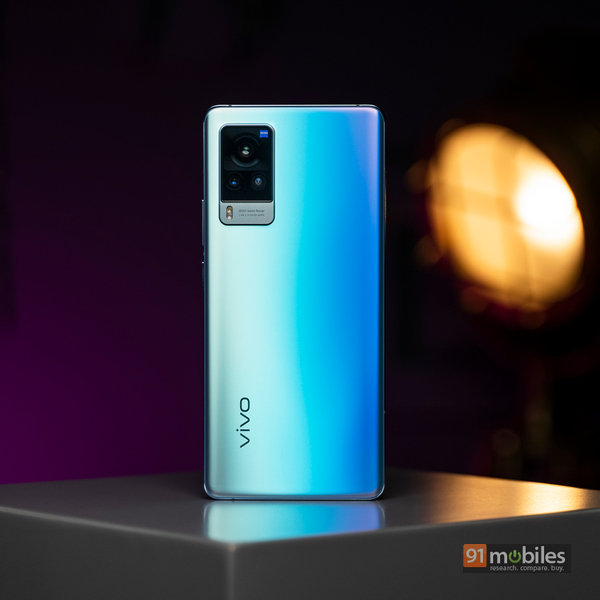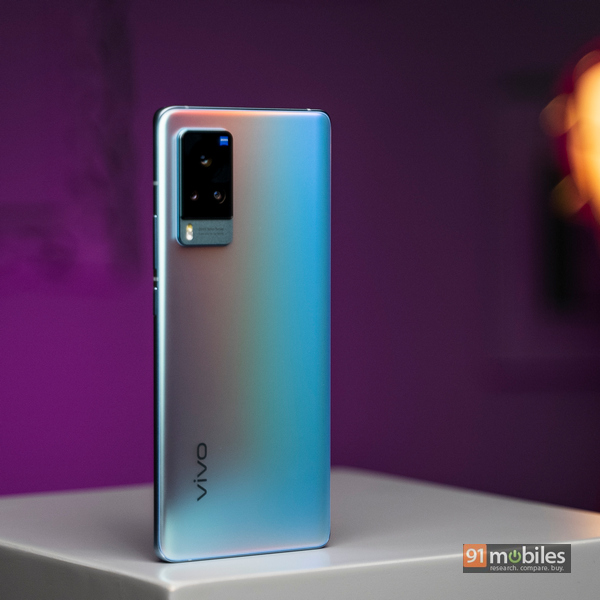Review Summary
Expert Rating
Many of Vivo’s smartphones have been premium, flagship-grade devices, especially the ones we’ve seen in recent years. And some have even been at the forefront of bringing new technologies to mobile phones. You might remember that the first phone with an in-display fingerprint sensor, the one with the first pop-up camera and even the first phone with OIS, were all part of Vivo’s lineup. I had reviewed the Vivo X50 Pro (review) earlier last year which was the first phone that came with gimbal tech on the primary camera sensor. Despite offering extremely capable cameras, the X50 Pro lacked the kind of internals that constituted a flagship phone, and the asking price of Rs 50k didn’t help. Now, it seems Vivo is finally changing tack. Enter the Vivo X60 series, which has three smartphones in the lineup for now, namely the Vivo X60, X60 Pro, and X60 Pro Plus. In this review, I will be focusing on the Pro model that makes use of the previous iteration’s Gimbal camera and is also the first phone to launch in India with the Qualcomm Snapdragon 870 chipset. With the phone being priced at Rs 49,990, will it help Vivo achieve the high-end flagship formula? Let’s take a deeper look.

Table of Contents
Verdict
The Vivo X60 Pro is my top recommendation of the sexiest phones of 2021. It’s got the looks, the in-hand feel, the build materials and an overall premium swagger oozing out of it. Vivo’s prowess in offering capable optical hardware is on display with the X60 Pro and it has the results to show for it. Performance and display metrics also put the X60 Pro at the very top of the smartphone pedestal, although you will notice the phone heating up from time-to-time under heavy GPU load. However, the battery life is sub-par and the software, while improved, still has bloatware. The lack of a few features like stereo speakers, IP rating, and wireless charging could be deal breakers though. If you are looking for something that feels light and premium in your hands, takes good photos and has the processing prowess to back it, the X60 Pro is a great choice.

Design and display
Just from holding the device, it is clear that the Vivo X60 Pro is following its predecessor’s footsteps of being the slickest phone in the market. The Frosted-matte AG Glass implementation across the phone feels nice to the touch while also acting somewhat of a fingerprint deterrent. The gradient finish goes extremely well with the back and matches the sloping rails across the frame. The massive Gimbal lens and its subsequent camera housing jut out slightly from an otherwise extremely thin chassis. Matter of fact, at 7.59mm, the X60 Pro might be the thinnest smartphone out there in its segment.

The sleek looks complement the incredibly light in-hand feel as well, with the device weighing just 177g. The glass back seems durable enough, although I did get nicked from a couple of coins in my pocket. It would be nice if Vivo provided some kind of clear silicone case inside the box, but at least you get a charging brick and a pair of wired earphones. I still marvel at how extremely well-built the device feels despite its slimness and the curved panels on the front and back. The volume rocker and power buttons are on the side of the device and on the bottom is the single speaker grille, USB-C port, and dual-SIM slot. I’m going out on a limb here and declaring the X60 Pro as the sexiest phone launched till now this year.

A nearly bezel-less display makes up the front of the device with the curved sides melting into the thin frame. The punch-hole, housing the selfie shooter, moves to the centre and is extremely small in surface area. The screen itself measures a healthy 6.5-inch diagonally and combines well with the narrow design for easy one-handed usage. You get an AMOLED panel with a smooth 120Hz refresh rate offering FHD+ (2,376 x 1,080) resolution. I’ve been quite impressed with Vivo’s displays in some of its earlier flagship smartphones and the X60 Pro doesn’t disappoint either. The panel can achieve 800 nits of peak brightness, which means outdoor viewing isn’t a problem. Contrast ratios and colour tones are quite good across the screen and the OLED nature allows for deeper blacks. Adjustments can always be made to suit your colour profile in display settings. The 120Hz refresh rate does not change dynamically based on the requirement at first unless you set it to Smart Switch. You are also covered for OTT platform viewing with the X60 Pro’s screen having HDR10+ certification. The viewing experience feels quite rounded up and easy on the eye which compliments the flagship-grade quality that Vivo is trying to achieve.

Cameras
I had reviewed the Gimbal camera on the Vivo X50 Pro, and written about its merits for the enhancement of smartphone photography. This time around you get the same 48MP Sony IMX598 primary sensor that sits on a “Double-Ball Suspension Mount” for up to 300 percent more stability. The sensore also has the largest aperture size I’ve seen to date at f/1.48. Apart from that, Vivo has partnered up with Swiss optics maker Zeiss which has co-engineered the lenses on the X60 series. Vivo says that Zeiss’s inputs have corrected a lot of edge distortions in landscape shots, suppressed flaring and ghosting in indoor shots, and provide a ‘Vortex’ like blur effect in portrait shots. There’s a lot of scientific jargon being thrown around the primary shooter but basically, it boils down to how much does the new Gimbal Synchronization 2.0’s stability help in the photography department.

To be quite honest, the Vivo X60 Pro really does take excellent daylight shots with superb colour accuracy. Focusing is snappy and when you shine a light on the primary camera you can actually see the gimbal mechanism physically correcting the lens’ positioning. It is pretty cool to capture fairly detailed shots even while shaking the phone, so you won’t have any problems with fast-moving objects. Automatic AI scene detection amps up colour tones according to what I’m shooting but I usually prefer to keep it off. For increased awareness of the stability, there is always the Pro mode that gives you access to a variety of manual adjustments including the Gimbal Radar. The Dynamic range across varied lighting remains mostly constant and I like how the sensor tones down exposure to get it more detail.

The other two lenses comprise a 13MP ultra-wide-angle shooter that has a 120-degree field of view and also does macro photography while the other is a 2X telephoto shooter with the same 13MP resolution. None of these two lenses have Gimbal support or OIS, so it was expected that some amount of detailing falls short. Even so, the ultra-wide camera does manage to pull off some great looking shots with minimal warping at the edges. The macro shots also turn out quite decent although the colours can look overly bright. Switching between lenses is spontaneous and colour temperature are mostly maintained. I quite liked the periscope 5X telephoto shooter on the X50 Pro and the 2X telephoto lens does feel like a downgrade. Nevertheless, shots from the latter match up to my expectations.

There’s a whole lot of night photography wizardry going behind the scenes and the results are mostly good. Actually, in just about any kind of dim lighting, indoors or outdoors, the X60 Pro does a tremendous job. The gimbal helps keep the low-light shots sharp for maximum detail and focus. The highlights are prominent and the shots are not subject to lots of oversharpening. However, in cases of extremely low light, the graininess and noise start to seep in more prominently. In some case, I also saw a greenish tint dominating shots that has a single source of lighting. The Night mode does not specifically add a lot of details in this scenario. In fact, the stability provided by the Gimbal negates any use of the Night mode. Additionally, you have Astro mode and Super Moon mode for clicking the starry sky and the full moon provided conditions are right. Gimmicks aside, I was generally quite impressed with low-light shots but I think there is room for improvement. Just have a look at the Night mode shot from the OnePlus 8 Pro below compared with the Vivo X60 Pro.


Video-wise, the phone can shoot extremely detailed 4K videos @ 60fps and with the added benefit of the 5-axis Gimbal stability, the footage is very smooth. Apart from that, you have the ultra-stable shooting mode that functions only in 1080p but gives out supremely smooth videos even in low light. On the front is a capable 32MP selfie shooter that clicks some of the best selfies in the Android world. There is almost no facial smoothening and I’m quite impressed with skin tones matching perfectly.
Performance and software
While the Snapdragon 888 is the flagship 5nm chipset from Qualcomm, the Snapdragon 870 that powers the X60 Pro is just a notch below. The latter still packs in quite a punch and offers incremental updates over last year’s Snapdragon 865 chipset. I have a couple of benchmark numbers that should put to rest any qualms regarding the 870’s processing power. On Antutu, the Vivo X60 Pro got an overall score of 636,019 while on Geekbench’s single-core and multi-core tests the device scored 1,031 and 2,998. In comparison, Samsung’s Exynos 2100 (a 5nm chipset and a rival to the Snapdragon 888) on the Galaxy S21 Ultra (review) got an Antutu score of 646,482.

The X60 Pro is not going to be a disappointment in terms of any performance needs you have from your device. The phone can handle pretty much everything without breaking a sweat. I do, however, felt the phone getting unreasonably hot from time-to-time while doing some heavy mobile gaming. Not that it affects the in-game performance in any way, but it is something to keep in mind. Even while running Antutu, which is a 5-minute benchmark, the device gained nearly 9 degrees in temperature and dropped 5 percent battery.

The phone comes with an in-display fingerprint sensor of the optical variety and is extremely snappy at authentication, as I expect it to be. A feature that did pique my interest was virtual RAM which added up to 3GB more memory than the allocated 12GB. Vivo says it has used “innovative memory management technology” which distributes some of the RAM to the internal storage, thereby allowing more apps to be open in the background. To be honest, 12GB of RAM is more than enough for any kind of background tasks, so the addition of 3GB more didn’t make any significant difference. It does seem like a cool thing to have anyway. It’s just a pity that the in-built RAM is LPDDR4 instead of the faster LPDDR5 that most flagship smartphones come with. At least you get fast UFS 3.1 storage which is fixed at 256GB. Communications-wise the device has support for 5G and the Indian telecom market is likely to be equipped with the required infrastructure by year-end. The ysual 4G calls on Jio’s Noida circle were completely fine, as was the earpiece and mic quality on the device. However, the single bottom-firing speaker certainly has no depth to it and the lack of stereo bugs me for a phone priced this much. The haptics aren’t too great as well, in fact, I’ve had a better typing experience on the significantly cheaper Redmi Note 10 Pro Max (review).

On the software side, the Vivo X60 Pro runs on the proprietary FunTouchOS 11 which is based on Android 11. Now I won’t say that I like Vivo’s UI implementation, but there are significant improvements as compared to previous iterations. The settings menu has become more concise and looking for customisation options has been made much simpler. The overtly bright themes have been toned down and I like the different Always-on display designs provided by default. A dedicated app drawer, Google Feed integration, easy widget placement and useful shortcuts in the navigation bar, all make for a reasonably good user experience. Not to say I don’t have any qualms. There is still a lot of bloatware and I hate that the phone defaults to the Vivo browser instead of Chrome or if you want to download an APK file, it directs you to the Vivo Store instead of the Play Store. Some of Vivo’s apps keep pushing unnecessary notifications until you manually disable them. There is scope for improvement, but I really think that Vivo is getting there faster than I had expected.

Battery
The battery life on the Vivo X60 Pro is nothing spectacular and it is kind of understandable given the extremely thin chassis of the device. You get a 4,200mAh battery on the device, which provides up to a day’s worth of usage when used judiciously. More often than not, I did find the phone dying on me before the day ended so do keep that in mind. The screen-on time was somewhere in the range of 5-6 hours which is just above average in today’s flagship segment. There’s no wireless charging on the device but you do get wired 33W FlashCharge support. It can juice up the phone from 0-100 percent in about 70-80 minutes. There are a couple of software tricks up the sleeve to extend battery life by lowering the screen refresh rate, restricting background processes and more. Bottom line, the phone is not a battery champ.

Final Verdict
There is no doubt in my mind that the Vivo X60 Pro has the best design in all the flagship devices I have tested so far this year. It feels extremely premium in the hand and at the same time, it’s been constructed with durability in mind. There is very little to complain about in the performance department apart from the unusual heating of the device during some heavy-ended graphics-based usage. The cameras are also exceptional, especially when you compare the low-light capabilities to some of the competing devices. Apart from that, the X60 Pro’s superlative display matches up to industry standards and packs in all the features that you could possibly want. Could the haptics have been better? Most definitely. The battery life is nothing to write home about and the lack of wireless charging or an official IP rating makes me question the price tag. FunTouch is in a state of improvement and still has some way to go.

The Rs 49,990 pricing puts the X60 Pro in direct competition with the OnePlus 9 (review). Both phones do have a lot of similarities. The display is nearly identical with the placement of the punch-hole camera being the only difference. OnePlus does have an advantage with the better Snapdragon 888 chipset but it definitely loses out on the camera department. I will also give design points to the X60 Pro simply because it is such a joy to hold. Neither phones have flagship features to offer, such as an IP rating or wireless charging. However, the OnePlus 9 does offer stereo speakers which the X60 Pro lacks. The OnePlus 9 also scores higher on the battery, especially for its faster 65W charging speeds. The software platform falls down to personal preference but I’d prefer OnePlus’ OxygenOS over Vivo’s FunTouch. I think that if smartphone photography, trendy design and good performance are strong points in your purchase decisions, then the Vivo X60 Pro is an excellent choice to consider.

Editor’s rating: 3.5 / 5
Pros
- Excellent photography
- Breathtaking design
- Speedy performance
Cons
- Phone heats up during gaming
- Battery life is not great
- No official IP rating
























![[Exclusive] iQOO is evaluating launch of gaming tablet in India Thumbnail](https://www.91-cdn.com/hub/wp-content/uploads/2024/04/Vivo-Pad-3-Pro-as-iQOO-Pad-2.png?tr=h-110,q-100,pr-true)
![[Update] Vivo V30e India launch date announced; key specifications and features revealed Thumbnail](https://www.91-cdn.com/hub/wp-content/uploads/2024/04/Vivo-V30e.jpg?tr=h-110,q-100,pr-true)








![[Exclusive] iQOO Z9 Turbo to launch as iQOO 12 Lite globally in Q3 2024 Thumbnail](https://www.91-cdn.com/hub/wp-content/uploads/2024/04/iQOO-12-Lite-100x70.jpg)
